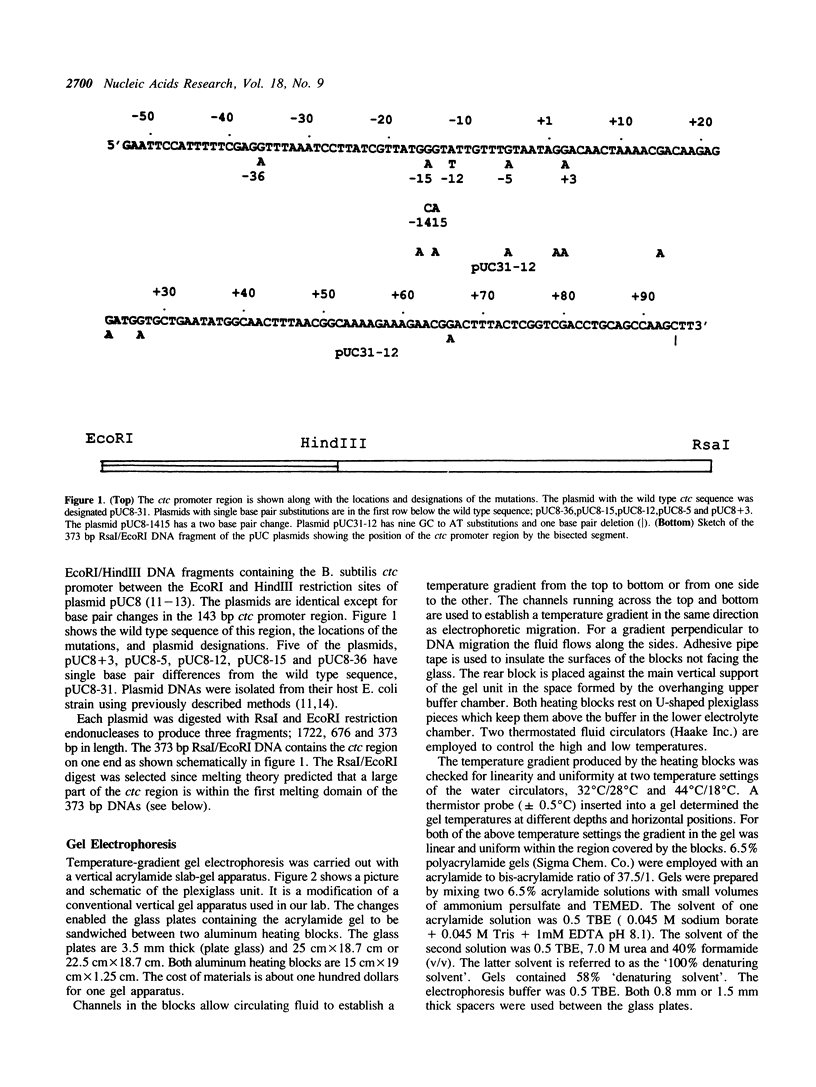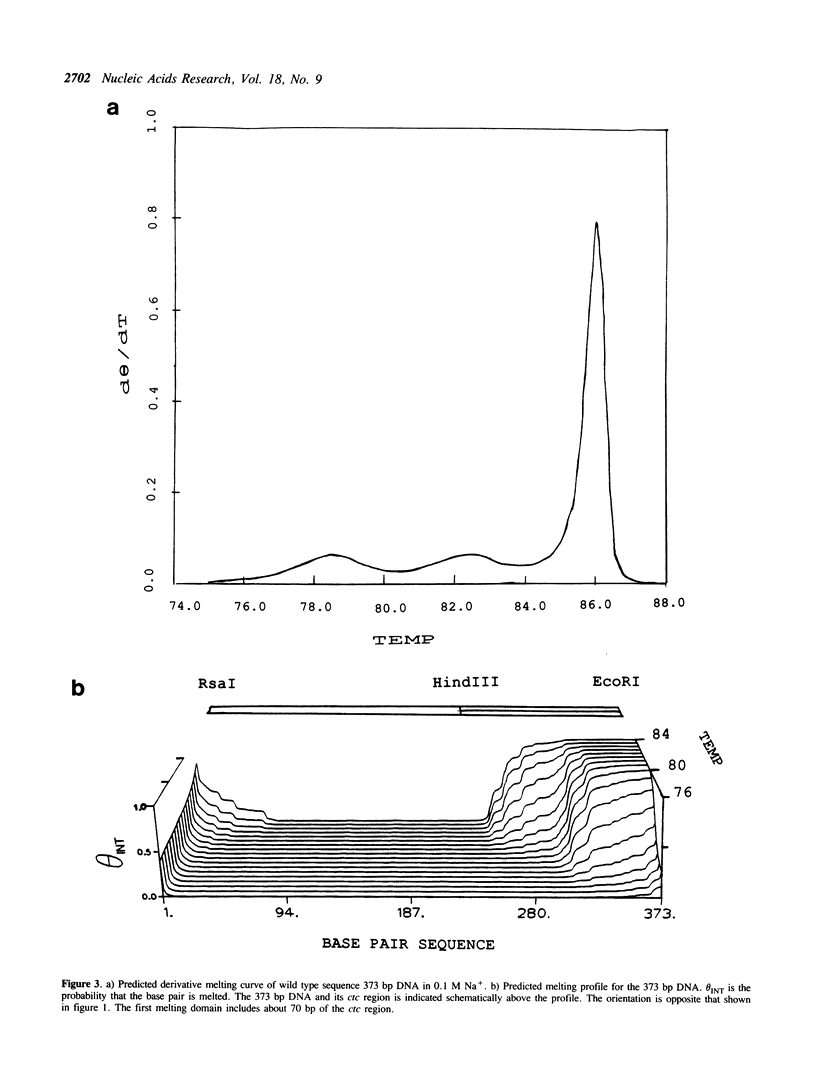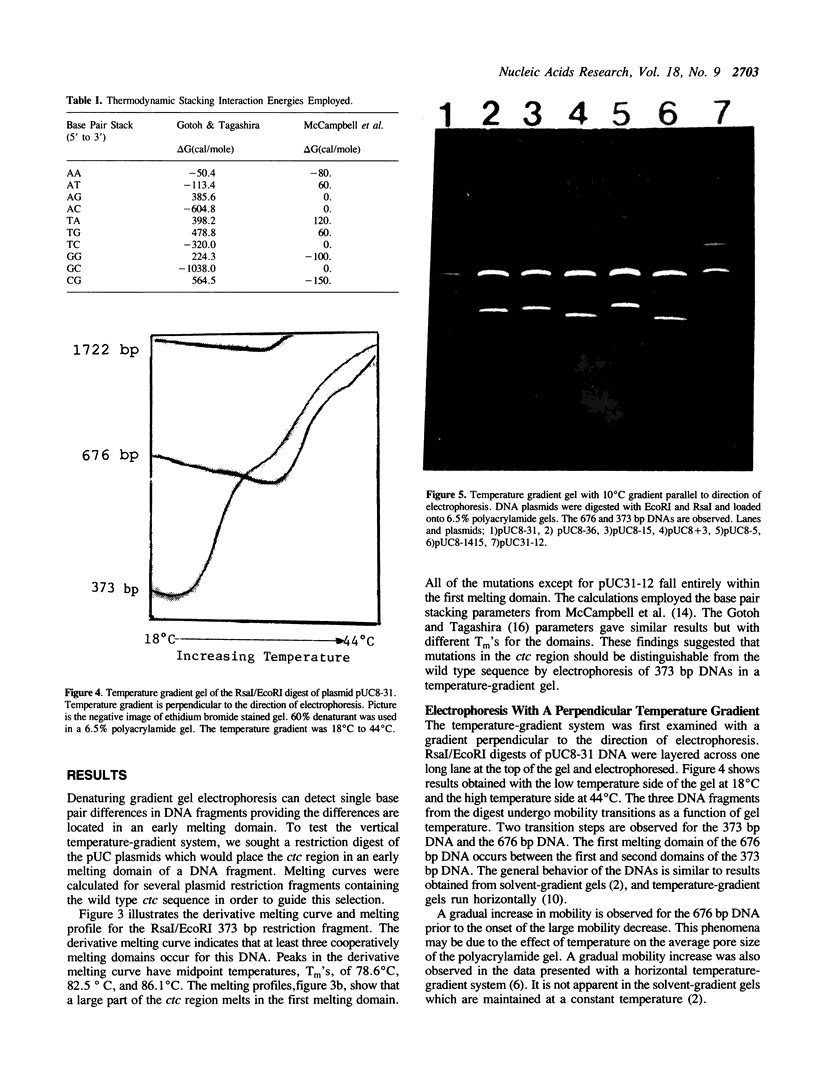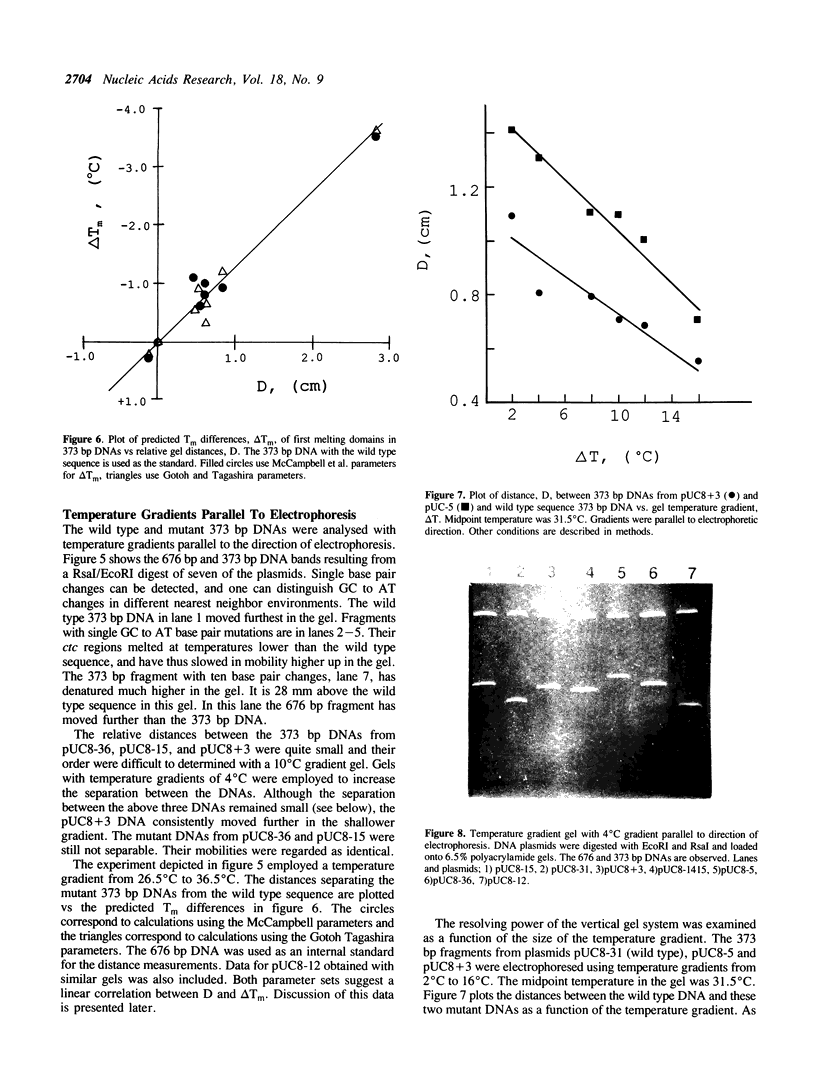Abstract
A vertical gel electrophoresis apparatus is described which can distinguish DNA fragments differing by single base pair substitutions. The system employs a homogenous polyacrylamide gel containing urea-formamide and a temperature gradient which runs either perpendicular or parallel to the direction of electrophoresis. The temperature-gradient system simplifies several features of the denaturant-gradient system (1) and is relatively inexpensive to construct. Eight homologous 373 bp DNAs differing by one, two, or nine base pair substitutions were examined. DNA electrophoretic mobility changed abruptly with the temperature induced unwinding of DNA domains. GC to AT substitutions at different locations within the first melting domain, as well as an AT to TA transversion were separated with temperature gradients parallel to the electrophoretic direction. The relative stabilities of the DNAs observed in the gels were compared to predictions of DNA melting theory. General agreement was observed however complete correspondence was not obtained.
Full text
PDF






Images in this article
Selected References
These references are in PubMed. This may not be the complete list of references from this article.
- Breslauer K. J., Frank R., Blöcker H., Marky L. A. Predicting DNA duplex stability from the base sequence. Proc Natl Acad Sci U S A. 1986 Jun;83(11):3746–3750. doi: 10.1073/pnas.83.11.3746. [DOI] [PMC free article] [PubMed] [Google Scholar]
- Fischer S. G., Lerman L. S. DNA fragments differing by single base-pair substitutions are separated in denaturing gradient gels: correspondence with melting theory. Proc Natl Acad Sci U S A. 1983 Mar;80(6):1579–1583. doi: 10.1073/pnas.80.6.1579. [DOI] [PMC free article] [PubMed] [Google Scholar]
- McCampbell C. R., Wartell R. M., Plaskon R. R. Inverted repeat sequences can influence the melting transitions of linear DNAs. Biopolymers. 1989 Oct;28(10):1745–1758. doi: 10.1002/bip.360281008. [DOI] [PubMed] [Google Scholar]
- Myers R. M., Fischer S. G., Lerman L. S., Maniatis T. Nearly all single base substitutions in DNA fragments joined to a GC-clamp can be detected by denaturing gradient gel electrophoresis. Nucleic Acids Res. 1985 May 10;13(9):3131–3145. doi: 10.1093/nar/13.9.3131. [DOI] [PMC free article] [PubMed] [Google Scholar]
- Myers R. M., Fischer S. G., Maniatis T., Lerman L. S. Modification of the melting properties of duplex DNA by attachment of a GC-rich DNA sequence as determined by denaturing gradient gel electrophoresis. Nucleic Acids Res. 1985 May 10;13(9):3111–3129. doi: 10.1093/nar/13.9.3111. [DOI] [PMC free article] [PubMed] [Google Scholar]
- Myers R. M., Lerman L. S., Maniatis T. A general method for saturation mutagenesis of cloned DNA fragments. Science. 1985 Jul 19;229(4710):242–247. doi: 10.1126/science.2990046. [DOI] [PubMed] [Google Scholar]
- Myers R. M., Lumelsky N., Lerman L. S., Maniatis T. Detection of single base substitutions in total genomic DNA. Nature. 1985 Feb 7;313(6002):495–498. doi: 10.1038/313495a0. [DOI] [PubMed] [Google Scholar]
- Oliver A. L., Wartell R. M., Ratliff R. L. Helix coil transitions of d(A)n-d(T)n, d(A-T)n-d(A-T)n, and d(A-A-T)n-d(A-T-T)n; evaluation of parameters governing DNA stability. Biopolymers. 1977 May;16(5):1115–1137. doi: 10.1002/bip.1977.360160512. [DOI] [PubMed] [Google Scholar]
- Sheffield V. C., Cox D. R., Lerman L. S., Myers R. M. Attachment of a 40-base-pair G + C-rich sequence (GC-clamp) to genomic DNA fragments by the polymerase chain reaction results in improved detection of single-base changes. Proc Natl Acad Sci U S A. 1989 Jan;86(1):232–236. doi: 10.1073/pnas.86.1.232. [DOI] [PMC free article] [PubMed] [Google Scholar]
- Tatti K. M., Kenney T. J., Hay R. E., Moran C. P., Jr Promoter specificity of a sporulation-induced form of RNA polymerase from Bacillus subtilis. Gene. 1985;36(1-2):151–157. doi: 10.1016/0378-1119(85)90079-4. [DOI] [PubMed] [Google Scholar]
- Tatti K. M., Moran C. P., Jr Promoter recognition by sigma-37 RNA polymerase from Bacillus subtilis. J Mol Biol. 1984 May 25;175(3):285–297. doi: 10.1016/0022-2836(84)90349-8. [DOI] [PubMed] [Google Scholar]
- Tatti K. M., Moran C. P., Jr Utilization of one promoter by two forms of RNA polymerase from Bacillus subtilis. Nature. 1985 Mar 14;314(6007):190–192. doi: 10.1038/314190a0. [DOI] [PubMed] [Google Scholar]
- Thatcher D. R., Hodson B. Denaturation of proteins and nucleic acids by thermal-gradient electrophoresis. Biochem J. 1981 Jul 1;197(1):105–109. doi: 10.1042/bj1970105. [DOI] [PMC free article] [PubMed] [Google Scholar]
- Vologodskii A. V., Amirikyan B. R., Lyubchenko Y. L., Frank-Kamenetskii M. D. Allowance for heterogeneous stacking in the DNA helix-coil transition theory. J Biomol Struct Dyn. 1984 Aug;2(1):131–148. doi: 10.1080/07391102.1984.10507552. [DOI] [PubMed] [Google Scholar]
- Wada A., Suyama A. Local stability of DNA and RNA secondary structure and its relation to biological functions. Prog Biophys Mol Biol. 1986;47(2):113–157. doi: 10.1016/0079-6107(86)90012-x. [DOI] [PubMed] [Google Scholar]





